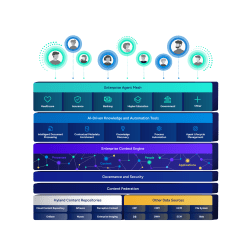What does moving to the Hyland Cloud look like?
Migrating to the cloud is a significant move for any business, and a smooth and efficient transition is contingent on extensive planning and a detailed migration strategy.
If you’re looking to migrate your content or business solutions to the Hyland Cloud, here is a snapshot of the migration process:
1. Complete a content inventory
Before launching your cloud migration, perform a content inventory to review what moves to the cloud, what stays behind and why. Use this opportunity to identify any redundant or obsolete documents before disposing of them according to legal and compliance requirements.
With the Hyland Cloud’s scalable infrastructure, businesses can easily expand or reduce resources to accommodate their content needs without being limited by physical storage restraints.
2. Deliver a copy of your cloud-bound content to your cloud provider
Once you’ve identified which content will be moved to the cloud, send it to your cloud provider so they can begin setting it up in its new home on the cloud.
3. Perform rigorous testing
Begin with a pilot test of smaller, less mission-critical applications or data. Remember to track changes and ensure that all necessary changes are applied before they go live.
4. Schedule the go-live date
Once testing is complete, it’s time to go live. Hyland will schedule a “go live” date that is most convenient for you to minimize operational disruptions and downtime.
5. Prepare to launch
Before the final migration, stop all on-premises solution work to enable a clean cutover from on-prem to the cloud.
6. Final testing
Put the solution through one last round of testing to check that everything is functioning as intended before going live.
7. Time to go live
Your solution is live, and your organization is now ready to reap the benefits of your Hyland Cloud-hosted solution!


















